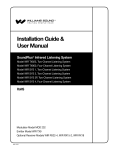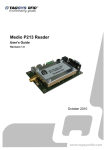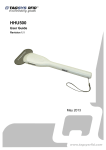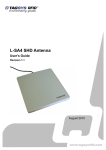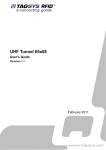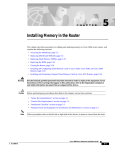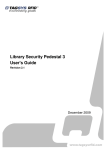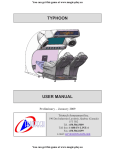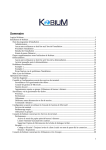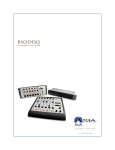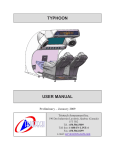Download Medio P232 P233 - User Guide v1-0
Transcript
Medio P232, P233 Readers User's Guide Revision 1.0 October 2010 Medio P232, P233 Readers User's Guide Publishing Information Disclaimer and Limitation of Liability All information herein is either public information or is the property of and owned solely by TAGSYS who shall have and keep the sole right to file patent applications or any other kind of intellectual property protection in connection with such information. Nothing herein shall be construed as implying or granting to you any rights, by license, grant or otherwise, under any intellectual and/or industrial property rights of or concerning any of TAGSYS’ information. This document can be used for informational, non-commercial, internal and personal use only provided that: ♣ the copyright notice below, the confidentiality and proprietary legend and this full warning notice appear in all copies. ♣ this document shall not be posted on any network computer or broadcast in any media and no modification of any part of this document shall be made. Use for any other purpose is expressly prohibited and may result in severe civil and criminal liabilities. The information contained in this document is provided “AS IS” without any warranty of any kind. Unless otherwise expressly agreed in writing, TAGSYS makes no warranty as to the value or accuracy of information contained herein. The document could include technical inaccuracies or typographical errors. Changes are periodically added to the information herein. Furthermore, TAGSYS reserves the right to make any change or improvement in the specifications data, information, and the like described herein, at any time. Therefore TAGSYS assumes no liability and is not responsible for customer applications or product or software which include TAGSYS products. TAGSYS HEREBY DISCLAIMS ALL WARRANTIES AND CONDITIONS WITH REGARD TO THE INFORMATION CONTAINED HEREIN, INCLUDING ALL IMPLIED WARRANTIES OF MERCHANTABILITY, FITNESS FOR A PARTICULAR PURPOSE, TITLE AND NON-INFRINGEMENT. IN NO EVENT SHALL TAGSYS BE LIABLE, WHETHER IN CONTRACT, TORT OR OTHERWISE, FOR ANY INDIRECT, SPECIAL OR CONSEQUENTIAL DAMAGES OR ANY DAMAGES WHATSOEVER INCLUDING BUT NOT LIMITED TO DAMAGES RESULTING FROM LOSS OF USE, DATA, PROFITS, REVENUES, OR CUSTOMERS, ARISING OUT OF OR IN CONNECTION WITH THE USE OR PERFORMANCE OF INFORMATION CONTAINED IN THIS DOCUMENT. TAGSYS does not and shall not warrant that this product/system/equipment will be resistant to all possible attacks, and shall not incur, and disclaims, any liability in this respect. Even if each product is compliant with current security standards in force on the date of their design, security mechanisms' resistance necessarily evolves according to the state-of-the-art in security and notably under the emergence of new attacks. Under no circumstances shall TAGSYS be held liable for any third party actions, and in particular in case of any successful attack against systems or equipment incorporating TAGSYS products. TAGSYS disclaims any liability with respect to security for direct, indirect, incidental or consequential damages that result from any use of its products. It is further stressed that independent testing and verification by the person using the product is particularly encouraged, especially in any application in which defective, incorrect, or insecure functioning could result in damage to persons or property, denial of service, or loss of privacy. © 2000-2010 TAGSYS. All rights reserved. Microsoft, Visual C++, Windows, and Windows NT are either registered trademarks or trademarks of Microsoft Corporation in the U.S.A. and/or other countries. I-Code is a registered trademark of Philips. Tag-It is a registered trademark of Texas Instruments. Printed in France. TAGSYS – 785 Voie Antiope, Athélia III, 13600 La Ciotat, France. Tel: +33 (0) 4.42.18.89.00 / Fax: +33 (0) 4.42.18.89.01 Document Reference: DOC14199A0 2/40 Revision 1.0 October 2010 Medio P232, P233 Readers User's Guide Read This First Welcome to the TAGSYS range of products operating at the 13.56 MHz frequency. This range of products is used to implement high-quality RFID systems for demanding applications. Audience This document requires familiarity with RFID technology. It is intended for people in charge of installing and using the product. Conventions Symbol Meaning CAUTION: A note that advises users that a specific action could result in the loss of data or damage the hardware. WARNING: A note that advises users that a specific action may result in physical harm. A note that provides additional information that helps the user to perform a task or obtain the best performance from the product. Abbreviations and Acronyms AFI Application Family Identifier AON All Or None API Application Programming Interface ASK Amplitude Shift Keying CPU Central Processing Unit CRC Cyclic Redundancy Check DLL Dynamic-Link Library DPU Digital Processing Unit DSFID Data Storage Format Identifier DSP Digital Signal Processor EAS Electronic Article Surveillance ETX End of Text HPI Host Port Interface I/O Input/Output IFD Interface Device LED Light Emitting Diode LSB Least Significant Bit October 2010 Revision 1.0 3/40 Medio P232, P233 Readers User's Guide MSB Most Significant Bit OS Operating System PC Personal Computer PCB Printed Circuit Board RAM Random Access Memory RF Radio Frequency RFID Radio Frequency Identification RFU Reserved for Future Use RPU Radio Processing Unit RTC Real Time Clock RTF Reader Talks First SAM Security Access Module STX Start of Text TTF Tag Talks First TTL Transistor-Transistor Logic TTY TeleTYpe UID Unique Identifier Glossary Anti-Collision Tag capability making it readable while other tags are present in the RF field. Antenna An aerial that receives and/or transmits radio frequency signals. Aerials are manufactured in a variety of forms, shapes and sizes. Baud A unit of measure of data transmission speed representing the number of signal changes per second. BNC Connector Cylindrical metal connector with a copper core that is located at the tip of a coaxial cable, and is used to connect cables together. It attaches by pushing and twisting the outer cylinder on to two locking pins. Coupler See Reader. Data Storage Format Identifier Identifies the structure of the data stored in the smart label. Dynamic-Link Library Executable routines that are stored as separate files with DLL extensions and executed only when needed by the program. Host Port Interface Interface used to access the DSP memory. IEC Connector Three-pin connector used on sockets that carry mains electricity to the computer. All PCs use a male IEC connector and mains lead with a female IEC connector. Interrogation Pulse A signal transmitted by the coupler to activate the smart label’s transponder. Monitoring Port Parallel Port granting access to the HPI. It communicates directly with the Radio Processing Unit Multi-Read See Anti-Collision 4/40 Revision 1.0 October 2010 Medio P232, P233 Readers User's Guide Nibble Half a byte (4 bits) Packaged Reader A reader in its casing. Phase Shift Difference of phase between the 13.56 MHz field emitted by two antennas. This feature is dedicated to rotating field applications and three-dimensional volume smart label detection. Protocol A set of rules governing a particular function, such as the flow of data/information in a communication system (communication between a smart label and a reader or a reader and a PC or host computer). Radio Frequency Identification System (RFID) An automatic identification and data capture system comprising one or more readers and one or more smart labels in which data transfer is achieved by means of suitable modulated inductive or radiating electromagnetic carriers. Reader Electronic system for the communication between smart labels and host computers. Reader Talks First Chip protocol for exchanges between the reader and the chip, whereby the chip waits for a command from the reader to which it responds. RS-232 Electronic Industries Association (EIA) standard for serial interfaces between computers and peripherals which defines the function, the electrical characteristics and the timing of signals. RS-485 Electronic Industries Association (EIA) standard for multipoint, differential data transmission. It allows multiple nodes to communicate bi-directionally over 1 or 2 twisted pairs. Smart Label Small, flexible tag from the 13.56 MHz TAGSYS product line. A smart label is made of a chip connected to an etched antenna. Tag See Smart Label. Tag Talks First Chip protocol for exchanges between the reader and the chip, whereby the tag sends information continuously, without waiting for a specific command from the reader. Transceiver A combined transmitter and receiver. Transponder A combined receiver/transmitter that automatically transmits a signal when a ‘trigger’ is received by it. The trigger is often a pulse, called an interrogation pulse. October 2010 Revision 1.0 5/40 Medio P232, P233 Readers User's Guide If you need assistance Please contact your nearest TAGSYS sales representative or the TAGSYS Welcome Desk at: Telephone: +33 (0) 4 42 18 89 00 Fax: +33 (0) 4 42 18 89 01 E-Mail: [email protected] Website http://www.tagsysrfid.com Contact for Comments We welcome your feedback to help us provide high quality documentation. For technical comments, please contact our Welcome Desk: Telephone: +33 (0) 4 42 18 89 00 Fax: +33 (0) 4 42 18 89 01 E-Mail: [email protected] Please remember to quote the Document Reference number DOC14199A0, your job title and your company. Quality Issues TAGSYS implements stringent quality controls at all stages of its manufacturing process. However, should you find a defect with this product, please notify your TAGSYS Quality Service representative using the dedicated Product Return Form. 6/40 Telephone: +33 (0) 4 42 18 89 36 Fax: +33 (0) 4 42 18 89 01 Revision 1.0 October 2010 Medio P232, P233 Readers User's Guide Table of Contents PUBLISHING INFORMATION ..................................................................................................................... 2 DISCLAIMER AND LIMITATION OF LIABILITY .................................................................................................... 2 READ THIS FIRST......................................................................................................................................... 3 AUDIENCE ......................................................................................................................................................... 3 CONVENTIONS................................................................................................................................................... 3 ABBREVIATIONS AND ACRONYMS ................................................................................................................... 3 GLOSSARY ........................................................................................................................................................ 4 IF YOU NEED ASSISTANCE ................................................................................................................................ 6 CONTACT FOR COMMENTS .............................................................................................................................. 6 QUALITY ISSUES ............................................................................................................................................... 6 1 1.1 1.2 1.3 1.4 1.5 1.6 1.7 2 INTRODUCTION ...................................................................................................................................... 9 GENERAL ................................................................................................................................................. 9 PRODUCT DESCRIPTION ......................................................................................................................... 9 OPERATING MODES ................................................................................................................................ 9 SERIAL COMMUNICATION LINK .............................................................................................................. 9 PERIPHERAL DEVICES ............................................................................................................................ 9 MEDIO P232/P233 KEY FEATURES ..................................................................................................... 10 DELIVERY ............................................................................................................................................... 10 FUNCTIONAL OVERVIEW .................................................................................................................. 11 2.1 FUNCTIONAL BLOCK DIAGRAM ............................................................................................................ 11 2.2 COMMUNICATION PROTOCOLS ............................................................................................................. 12 2.2.1 TAG-TO-READER INTERFACE ............................................................................................................. 12 2.2.2 READER-TO-HOST INTERFACE .......................................................................................................... 12 2.3 PERIPHERAL DEVICES .......................................................................................................................... 13 3 INSTALLING THE READER................................................................................................................ 14 3.1 PIN CONNECTIONS ................................................................................................................................ 14 3.2 POWER SUPPLY .................................................................................................................................... 16 3.3 ANTENNA ............................................................................................................................................... 16 4 SERIAL COMMUNICATION LINKS ................................................................................................... 17 4.1 GENERAL INFORMATION ON DATA ACQUISITION ................................................................................ 17 4.1.1 INSTALLING THE TTL INTERFACE ...................................................................................................... 18 4.1.2 ELECTRICAL SIGNAL REQUIREMENTS ............................................................................................... 18 5 PX EXPLORER ...................................................................................................................................... 20 5.1 INSTALLING PX EXPLORER ................................................................................................................... 20 October 2010 Revision 1.0 7/40 Medio P232, P233 Readers User's Guide 5.2 RUNNING PX EXPLORER ....................................................................................................................... 22 5.3 READING AND WRITING A TAG ............................................................................................................. 23 6 STAND-ALONE MODE......................................................................................................................... 24 6.1 STAND-ALONE MODE FEATURES ......................................................................................................... 24 6.1.1 CUSTOMIZED ASCII MESSAGE FORMAT........................................................................................... 25 6.1.2 REPETITION OPTION ........................................................................................................................... 25 6.1.3 TRIGGER INPUT................................................................................................................................... 25 6.1.4 OUTPUT SETTINGS ............................................................................................................................. 26 6.2 STAND-ALONE MODE SETTINGS .......................................................................................................... 26 6.2.1 USING PX EXPLORER ......................................................................................................................... 27 6.3 DISABLING STAND-ALONE MODE......................................................................................................... 27 7 CONNECTING PERIPHERAL DEVICES .......................................................................................... 28 7.1 7.2 7.3 7.4 7.5 8 USING INPUT PIN ................................................................................................................................... 28 USING OUTPUT PIN ............................................................................................................................... 28 CONNECTING AN LED OR A BUZZER TO AN OUTPUT ......................................................................... 28 I/0 ELECTRICAL SIGNAL REQUIREMENTS ............................................................................................ 29 RESERVED PINS .................................................................................................................................... 29 TECHNICAL SPECIFICATIONS ......................................................................................................... 30 8.1 MEDIO P233 TECHNICAL SPECIFICATIONS ......................................................................................... 30 8.2 MEDIO P232 TECHNICAL SPECIFICATIONS ......................................................................................... 31 9 MECHANICAL CHARACTERISTICS................................................................................................. 32 9.1 DIMENSIONS AND GENERAL MECHANICAL INFORMATION.................................................................. 32 9.2 MARKINGS ............................................................................................................................................. 33 10 ELECTRICAL CHARACTERISTICS ................................................................................................ 34 10.1 ABSOLUTE MAXIMUM RATINGS .......................................................................................................... 34 10.2 POWER SUPPLY DC CHARACTERISTICS ........................................................................................... 35 11 WARRANTY CONDITIONS ............................................................................................................... 38 11.1 WARRANTY .......................................................................................................................................... 38 11.2 WARRANTY EXCLUSIONS ................................................................................................................... 38 11.2.1 GENERAL PROVISIONS ..................................................................................................................... 39 11.2.2 HOW TO RETURN DEFECTIVE PRODUCTS ...................................................................................... 39 8/40 Revision 1.0 October 2010 Medio P232, P233 Readers User's Guide 1 Introduction 1.1 General This document provides information on how to install and use Medio P232/P233 Smart Label Readers. 1.2 Product Description The TAGSYS Medio P232/P233 are mid range packaged RFID readers optimized to decode C210, C240, C270, C370, C370L, C370S and ISO15693 tags. The Medio P232/P233 readers offer the following features on a small printed circuit board: A high-performance radio processing unit operating at 13.56 MHz. A digital processing unit that incorporates chip decoding drivers. 1.3 Operating Modes The Medio P232/P233 have two operating modes: • Standard mode The reader is the slave of the master host system. It waits for a valid command from the host, performs the task and responds. This bi-directional communication is achieved via the STX-Enhanced 2 protocol. For more information, please refer to the Medio P200u/s, P213, P232/3 Command Set document. • Stand-alone mode The Reader is independent from the host system. Stand-alone mode is used by the P232/P233 readers to read tags and send their identification data to the host system. This transmission takes place in ASCII format. While in this mode, the reader cannot receive any commands. For more information, please refer to Section 6, “Stand-alone Mode”. 1.4 Serial Communication Link The P232/P233 readers are equipped with a TTL serial communication link. 1.5 Peripheral Devices One input and one output can check or drive external peripherals. The Input is compliant with TTL voltage levels (up to 5V). The output is CMOS/TTL-compatible. The I/O pins are mainly used for static applications such as reading sensors or driving LEDs, relays or buzzers. For more information, refer to Section 7.1 “Using the Universal Input pin” and Section 7.2 “Using the Universal Output pin”. In stand-alone mode the input can be used to trigger the RF scanning and the output to display a successful reading. For more information, refer to Section 6, “Stand-alone Mode”. October 2010 Revision 1.0 9/40 Medio P232, P233 Readers User's Guide 1.6 Key Features Table 1: Medio P232/P233 Key Features Description Medio P232/P233 Operating Frequency 13.56 MHz Compatibility C210, C240, C270, C370, C370L, C370S and ISO15693 tags Stand-alone Mode C210, C240, C270, C370, C370L, C370S and ISO15693 tags Primary Serial Link TTL Network Operation No TTL I/Os 1 input and 1 output Firmware upgradeable Yes 1.7 Delivery The Medio P232 / P233 TAGSYS RFID Tag Reader batch contains the following items: Table 2: Package Contents Quantity Item Batch Medio P232/P233TAGSYS RFID Tag Reader 1 CD-ROM including: 1 10/40 • Medio P232/P233 User's Guide • Medio P200u/s, P213, P232/3 Command Set • User-friendly Px Explorer software provided for test and debug operations on Windows® 9x, NT®, 2000 , XP, Vista, Seven platforms • MedioSTX Software Development Kit for Win32 and WinCE platforms with documentation and sample code • Universal Software Development Kit for Win32 platforms with documentation and sample code Welcome Letter / Product Return Form Revision 1.0 October 2010 Medio P232, P233 Readers User's Guide 2 Functional Overview This section provides an overview of the architectural structure and peripheral devices of the Medio P232/P233 Smart Label Readers. It also provides a summary of the special functions used to drive the reader board and describes the automatic features managed by the Central Processing Unit (CPU). 2.1 Functional Block Diagram The Medio P232/P233 architectural structure is based on a CPU that drives all reader functions. It manages communications between the host system (connected to the “Reader-to-Host interface”) and one or more smart labels using an antenna (connected to the “Tag-to-Reader interface”). It also drives 1 Output and 1 Input that are CMOS/TTL. The following figure illustrates the general architecture of Medio P232/P233 Smart Label Readers. Figure 1: Overall Medio P232/P233 Architecture Power Supply Wide range Power Supply (1010-25V 25V) 1 Output/ Output/1 Input TTL Interface Central Processing Unit TTL Serial Link October 2010 Reader To Host Interface STXSTX-E Decoder/ Decoder/ Encoder Revision 1.0 Tag To Reader Interface Antenna Chip Decoding Drivers 11/40 Medio P232, P233 Readers User's Guide 2.2 Communication Protocols Figure 2: Medio P232/P233 Readers Communication Protocols 2.2.1 Tag-to-Reader Interface To read from smart labels, to write to their memory, or to activate their functions, a wide command set is available. For a complete list of embedded commands and their description, please refer to the Medio P200u/s, P213, P232/3 Command Set document. Each range of smart labels has its own specific set of commands. Table 3: Smart Label Dedicated Commands Smart Label Family Available Commands C210 Read UID C240 Read Pages Comments Set Password Write Page C270 Anticollision Select Selected Read Write Block Halt Reset Quiet Unselected Read ISO15693 ISO 15693 Inventory Implements the whole recursive algorithm described in the Part3 of ISO 15693 specification, Inventory Process ISO15693 Raw Request 2.2.2 Reader-to-Host Interface When the Medio P232/P233 readers are connected to an antenna, they act more as a protocol converter due to the wide range of tasks they can perform. For more information about these tasks, refer to the Medio P200u/s, P213, P232/3 Command Set document. Depending on the task requested by the user through the host interface, the reader retrieves information from the smart label or provides it with information using its own communication protocol. The reader then converts the result of the operation into STXE-2 protocol and returns the information to the host via the Reader-to-Host interface. For more information, refer to the Medio P200u/s, P213, P232/3 Command Set document. 12/40 Revision 1.0 October 2010 Medio P232, P233 Readers User's Guide The Reader-to-Host interface is the slave of the master host system. It waits for a valid command from the host, performs the task and responds. This bi-directional communication is achieved via the STX-Enhanced 2 protocol. (For more information, please refer to the Medio P200u/s, P213, P232/3 Command Set document.) 2.3 Peripheral Devices One input and one output can check or drive external peripherals. The Input is compliant with TTL/CMOS voltage. The output interface manages one pin that drives an external peripheral. Outputs consist of a full CMOS driver that can drive up to 20 mA (sunk or sourced). The I/O pins are mainly used for static applications such as reading sensors or driving LEDs, relays or buzzers. For more information, refer to Section 7.1 “Using the Universal Input pin” and Section 7.2 “Using the Universal Output pin”. In stand-alone mode the input can be used to trigger the RF scanning and the output to display a successful reading. For more information, refer to Section 6, “Stand-alone Mode”. October 2010 Revision 1.0 13/40 Medio P232, P233 Readers User's Guide 3 Installing the Reader This section explains how best to install the Medio P232/P233 Smart Label readers’ boards. The physical description of the readers boards are given in Section 9, “Mechanical characteristics”. 3.1 Pin Connections The Medio P232/P233 Smart Label readers’ boards have two connectors with outputs to the various peripheral devices, as illustrated: Figure 3: Connector Locations J1 is a 10 pins MOLEXTM connector type, reference part 53398-1090. Associated receptacle is 51021-1000 (with 50079 female Terminals). J2 is dedicated to plug the antenna cable. 14/40 Revision 1.0 October 2010 Medio P232, P233 Readers User's Guide The Medio P232 Smart Label reader board has two more connectors as illustrated: Figure 4 : Connectors locations (bottom view), only P232 J4 is a 10 pins, 2.00mm Pitch Milli-Grid™ Receptacle, Surface Mount connector type. MOLEXTM reference part is 0791091004. Associated receptacle is TMM-105-05-L-D-SM (SAMTEC reference). J3 is a 4 pins, 2.00mm Pitch Milli-Grid™ Receptacle, Surface Mount connector type. MOLEXTM reference part is 0791091001. Associated receptacle is TMM-102-05-L-D-SM (SAMTEC reference). October 2010 Revision 1.0 15/40 Medio P232, P233 Readers User's Guide The following table lists the pins associated with each peripheral device. Table 4: Pin Descriptions Pin Description Connector Power Supply VCC Supply Voltage J1-1, J4-1 Communication Links to the Host System RX_TTL Receive pin for TTL J1-4, J4-3 TX_TTL Transmit pin for TTL J1-5, J4-5 Antenna output pin J2, J3-1 or J3-3 Antenna ANT I/O Interface Input J1-7, J4-6 Output J1-10, J4-10 Ground Voltage Reference GND Ground (for power supply) J1-2, J4-2 GND Ground J1-3, J4-9 GND Ground (for antenna) J3-2, J3-4 Reserved Pins NC NC J1-6, J4-4 Do not connect J1-8, J4-7 NC J1-9, J4-8 Reserved pins are used for any CPU firmware upgrade. While updating firmware, Input is also used for programming. 3.2 Power Supply The power supply must be connected to a GND pin and to the VCC pin. It must be able to withstand a peak current of 600 mA when the reader is powered on. Please refer to Section 10, “Electrical characteristics” for more details about reader consumption. The VCC pin accepts an input voltage between 10 and 25 V. 3.3 Antenna The J2 connector is dedicated to an antenna that is required for reading smart labels. It is recommended to use a TAGSYS antenna. A coaxial cable (50 Ω impedance) as short as possible should be used. 16/40 Revision 1.0 October 2010 Medio P232, P233 Readers User's Guide 4 Serial Communication Links Medio P232/P233 Smart Label Readers are based on a Master-Slave communication system where the host system acts as the master and the reader as the slave. The Host-to-Reader interface accepts TTL levels communication links. 4.1 General Information on Data Acquisition Communication takes place by sending frames (bytes) on the communication link. The bytes are transmitted LSB first with one start bit and one stop bit as shown in the following figure. Figure 5: Structure of a Byte on the Communication Link 1 LSB MSB Start Bit 0 Stop Bit 8 bits with LSB First Communication parameters are listed in the following table. These parameters cannot be modified. Table 5: Parameters for the Transmission of a Byte Parameter Value Allowed Baud Rates 4800, 9600, 19200, 38400, 57600, 115200 (depending on the reader settings) Start Bit On Number of data bits 8 Parity None Stop bit 1 The transmission timeout between two bytes is 10 ms. The default Medio P232/P233 configuration is 38400 bps. October 2010 Revision 1.0 17/40 Medio P232, P233 Readers User's Guide Figure 6: TTL Serial Link Hardware Interface RX_TTL To the TTL Compatible Transmitter of the Host System TX_TTL To the TTL Compatible Receiver of the Host System GND To the Ground Reference Voltage of the Host System 5V Host To Reader Interface GND Refer to Table 5 and make sure you source and sink current according to parameters described. Rx Pin does have a weak Pull Up: Do not attempt to drive it with an open drain component as it is not a reliable and reproducible way to implement it. 4.1.1 Installing the TTL Interface To use the TTL Interface, pins TX_TTL and RX_TTL must be connected respectively to Transmit and Receive pins of the TTL-compatible communication link of the host system. The RX_TTL pin is compatible with TTL/CMOS levels. It needs to be driven by a full CMOS output driver. The TX_TTL pin is a full CMOS output driver. 4.1.2 Electrical Signal Requirements Both RX_TTL and TX_TTL pins have an inactive, high-level voltage. During the transmission of a byte, a bit set to 1 is coded by a low voltage and a bit set to 0 by a high one. 18/40 Revision 1.0 October 2010 Medio P232, P233 Readers User's Guide Communication 8 bits (LSB first) Stop Bit Inactive Start Bit Figure 7: TTL Signal during an Exchange Inactive Communication Table 6: TTL Interface Pins - Electrical Characteristics Parameters Min. RX_TTL Input Voltage Low 0 RX_TTL Input Voltage High 4 RX_TTL Input Current 1 Typ. Unit 1 V 5 V 0.6 4.3 V V TX_TTL Output Current 20 mA TX_TTL Output Capacitance 50 pF October 2010 Note µA TX_TTL Output Voltage Low TX_TTL Output Voltage High Max. Revision 1.0 Sunk or Sourced 19/40 Medio P232, P233 Readers User's Guide 5 Px Explorer The Medio P232/P233 readers are delivered with the Px Explorer software tool intended to easily setup the reader, test it and perform reading and writing operations according to the antenna and type of tag to be used. In addition, Px Explorer can display additional information such as the Product Reference, Firmware version and revision. This section describes how to start with Px Explorer. 5.1 Installing Px Explorer To install Px Explorer software, insert the product CD-ROM into the disk drive on your PC and run the Setup from the Software\Px Explorer folder and click “Next” Click the “Browse” button if you want to choose a specific installation folder. 20/40 Revision 1.0 October 2010 Medio P232, P233 Readers User's Guide Once the correct folder is selected, click “Next” October 2010 Revision 1.0 21/40 Medio P232, P233 Readers User's Guide Click “Next” to start the installation process. A shortcut will be created on your desktop and a program group will be created in the start menu. 5.2 Running Px Explorer Before running Px Explorer you have to know which COM port number is assigned to the TAGSYS Medio P232/P233 reader. To connect the Medio P232/P233 to a PC don’t forget to use a RS232/TTL serial converter. Power up the Medio P232/P233 and connect it to a PC. Run Px Explorer. If the following window is displayed click yes. 22/40 Revision 1.0 October 2010 Medio P232, P233 Readers User's Guide Open the Communication Settings window (CTRL+C) and check the COM port number and the communication speed. The default communication speed for the Medio P232/P233 is 38400 Bauds. Click OK. Now Px Explorer is ready to communicate with your Medio P232/P233 5.3 Reading and Writing a Tag Px Explorer includes a Wizard function used to guide you each step of how to read or program a tag. We recommend using the Wizard function for users who are not familiar with all Px Eplorer capabilities and features. Click on the Wizard icon (magic wand) to open the Px Explorer Wizard dialog box. Select the type of chip from the drop–down menu or place the tag on the antenna and click the “Detect “button to automatically detect the tag type. Select the desired operation (Read or Write) and then click OK. All the necessary windows to perform the desired action will be automatically displayed on the screen. For more details concerning Px Explorer select the info menu and click Help (CTRL+H) to display the Px Explorer User’s Guide October 2010 Revision 1.0 23/40 Medio P232, P233 Readers User's Guide 6 Stand-alone Mode Stand-alone Mode is designed to use the reader without using any command set. While in this mode, the reader is limited to tag reading. The reader sends the tag ID to the Host System using ASCII protocol via the Reader-to-Host interface. ASCII protocol is used in order to provide hexadecimal data that can be read by a variety of terminal programs (e.g. Microsoft® HyperTerminal). 6.1 Stand-alone Mode Features Table 7 lists the available Stand-alone mode features. Table 7: Available Features in Stand-alone Mode Features Medio P232/P233 Customized tag type reading C210 C240 C270 ISO15693 Serial Communication Type RS-232 RS-422 Baud Rate 4800, 9600, 19200, 38400, 57600, 115200 bps Repetition Option Available Customized ASCII message format STX/ETX Characters Header String Chip Description String ID String (variable length) End of Message String Input Trigger Available Output for active trigger information Available Output for tag reading information Available 24/40 Revision 1.0 October 2010 Medio P232, P233 Readers User's Guide 6.1.1 Customized ASCII Message Format When a tag is read, its data are transmitted to the host in the form of an ASCII character frame. Optional Optional 2 to 16 characters C240 2 to 16 characters C270 2 to 16 characters ISO15693 2 to 16 characters Required End of Message String End of Text <ETX> (0x03) 1 character Optional C210 <CR/LF> (Default) 0 to 16 characters ID Chip Description String 0 to 16 characters P232/P233 “TAGSYS-“ Chip name (Default) 0 to 16 characters Size <STX> (0x02) 1 character Description Header String Start of Text Table 8: Customized ASCII Message Format (TAGSYS RFID Tag is read) Optional Optional P232/P233 readers can decode all chips in Stand-alone mode. Only the ID field is retrieved in the return ASCII message. All other fields are optional. The ID field length is programmable; the default lengths are given in Table 9. Table 9: Default ID Field Lengths Chip Type Default ID Field Length C210 chip 16 (Total memory) C240 chip 16 (Block 0 Page 0) C270 chip 16 (Block 0 and Block 1) ISO15693 chip 16 (UID) 6.1.2 Repetition Option The reader constantly attempts to read any chips present in the field. When a chip ID is detected, the reader can send the information to the host in one of 2 modes: 1. In “Repeated Read” mode, the reader returns a chip’s ID to the host with each successful read operation. 2. In “Read Once” mode, the reader only returns the ID of a chip if the previous read corresponds to a different chip, or if all reading attempts have failed 4 times (this feature makes it possible to detect a chip’s potential exit out of the field). 6.1.3 Trigger Input When the trigger capability is enabled, a trigger state is used to start and stop the RF scanning. The trigger is connected to the input of the reader. Depending on the reply settings of the trigger, the ASCII message can be sent during the trigger activity (Repeated Read mode and Read Once mode are available) or at the end of the trigger. In this last case, a message is always sent to the host system: ♣ if a tag has been read, the message contains its ID, October 2010 Revision 1.0 25/40 Medio P232, P233 Readers User's Guide ♣ if a tag has not been read, the message contains a No Message string (that can be defined) as shown in Table 10. Table 10: Customized ASCII Message Format (TAGSYS RFID Tag is not read) Start of Text Header String No Tag Found String End of Message String End of Text Description <STX> (0x02) “TAGSYS-“ (Default) “????????“ (Default) <CR/LF> (Default) <ETX> (0x03) Size 1 character 0 to 16 characters 0 to 16 characters 0 to 16 characters 1 character P232/P233 Optional Optional Required Optional Optional 6.1.4 Output Settings The output of the reader can be used to monitor the trigger activity or the successful reads. 6.2 Stand-alone Mode Settings Stand-alone Mode can be set in one of two ways while the reader is in Normal Operating mode • By using the Px Explorer software provided with the reader • By using “Set Stand-alone Mode” command followed by a “Reset Reader” command. For more information, refer to the Medio P200u/s, P213, P232/3 Command Set document. 26/40 Revision 1.0 October 2010 Medio P232, P233 Readers User's Guide 6.2.1 Using Px Explorer Run the Px Explorer software. In the Settings menu, select General Reader Settings Enable Standalone mode at next power on 6.3 Disabling Stand-alone Mode The Medio P232/P233 can be reset in Standard mode in one of two ways as described below: • Use the Px Explorer software provided with the reader and click Yes when the following window is displayed • Send the 'S' character using a console interface (for example, HyperTerminal). October 2010 Revision 1.0 27/40 Medio P232, P233 Readers User's Guide 7 Connecting Peripheral Devices 7.1 Using Input Pin The reader input can be driven by a voltage source from 0V up to 5V referring to the input ground. A relay (open chain transistor, switch…) can also be used to connect the input pin and its ground. - Low level input voltage is defined to be in the range of 0 to 1V - High level input voltage is defined to be in the range of 4 to 5V 7.2 Using Output Pin Each output pin voltage is compatible with the TTL/CMOS level and is driven by a full CMOS output driver. Figure 8: Hardware Interface with Outputs 5V IOx To the TTL /CMOS -compat ibl e I nput GND To t he Ground Reference V olt age of the TTL/ CMOS -c ompatible Input Input / Output Interface GND 7.3 Connecting an LED or a Buzzer to an Output An LED or a buzzer can be triggered thanks to an output pin. This operation is executed by the host system application. An external serial resistor is needed for this connection if the current must be limited. 28/40 Revision 1.0 October 2010 Medio P232, P233 Readers User's Guide 7.4 I/0 Electrical Signal Requirements The following table provides the electrical DC characteristics. Table 11: I/O Interface Pins - Electrical Characteristics Parameters Conditions Min. Output Voltage Low Output Voltage High Typ. Max. Unit 0.6 V 4.3 Note V Output Current 20 mA Sunk or sourced Output Capacitance 50 pF Input Voltage Low 0.2VDD V VDD = 4.5 to 5.5V Input Voltage High 0.8VDD V VDD = 4.5 to 5.5V 7.5 Reserved Pins These pins must NOT be connected or unpredictable results may occur. October 2010 Revision 1.0 29/40 Medio P232, P233 Readers User's Guide 8 Technical Specifications 8.1 Medio P233 Technical Specifications Table 12: Medio P233 Technical Specifications Reference Medio P233 Size (L x W x H) 40 x 60 x 7 mm Weight 13 g DC power 9 to 25 V C210 C240 C270 C370/C370L-S ISO15693 Chip compatibility Communication interface TTL RF Output Power 1W Operating temperature 0° to +85°C Storage temperature -20° to +85°C Mechanical fixation Mechanical fixation with 4 screws (3 mm) MOLEX Connection mechanisms TM (533988-1090 header, 51021-1000 receptacle, 50079 female terminals) for supply and control signals UFL connector type for antenna Communication protocol in Standard mode 30/40 TAGSYS-specific STXE-2 Revision 1.0 October 2010 Medio P232, P233 Readers User's Guide 8.2 Medio P232 Technical Specifications Table 13: Medio P232 Technical Specifications Reference Medio P232 Size (L x W x H) 40 x 60 x 11.7 mm Weight 14 g DC power 9 to 25 V C210 C240 C270 C370/C370L-S ISO15693 Chip compatibility Communication interface TTL RF Output Power 1W Operating temperature 0° to +85°C Storage temperature -20° to +85°C Mechanical fixation Mechanical fixation with 4 screws (3 mm) MOLEX MOLEX TM MOLEX TM Connection mechanisms TM (533988-1090 header, 51021-1000 receptacle, 50079 female terminals) for supply and control signals (0791091004 header) and SAMTEC (TMM-105-05-L-D-SM receptacle) for supply and control signals UFL connector type for antenna (0791091001 header) and SAMTEC (TMM-102-05-L-D-SM receptacle) for antenna Communication protocol in Standard mode October 2010 TAGSYS-specific STXE-2 Revision 1.0 31/40 Medio P232, P233 Readers User's Guide 9 Mechanical Characteristics 9.1 Dimensions and General Mechanical Information Figure 9: Medio P233: Mechanical Dimensions (Side View) 7 mm 1.6 mm Figure 10: Medio P232: Mechanical Dimensions (Side View) 7 mm 4.7 mm 1.6 mm Figure 11: Medio P232/P233 Coupler: Mechanical Dimensions (Top View) The values given for dimensions are in millimeters and have a tolerance of 0.2 mm. Fixation holes are metallic. Their diameter is 3.1mm. 32/40 Revision 1.0 October 2010 Medio P232, P233 Readers User's Guide Figure 12: Medio P232: Mechanical Dimensions (Top View of the reader) By transparency we can see the connectors located on the bottom side. 9.2 Markings The firmware application programmed in the reader and its version number are indicated on an adhesive strip on the processor unit of the reader. October 2010 Revision 1.0 33/40 Medio P232, P233 Readers User's Guide 10 Electrical Characteristics This chapter provides information about AC and DC and characteristics for all pins. It also gives timing characteristics for the different interfaces. 10.1 Absolute Maximum Ratings Parameter Value Ambient Operating Temperature 0°C to +85°C Storage Temperature -20°C to +85°C Supply Voltage (VCC pin) with respect to GND 30 V Total Power Dissipation 1.4 W Total Power Dissipation on Antenna (ANT pin) 1W DC Current Allowed on VCC Pin 400 mA Peak Current Allowed on VCC Pin 800 mA Output Current Sunk by outputs and TX_TTL pins 20 mA Output Current Sourced by outputs and TX_TTL pins 20 mA 34/40 Revision 1.0 October 2010 Medio P232, P233 Readers User's Guide 10.2 Power Supply DC Characteristics Typical Input Current (from supply) Input Current VS Supply voltage 0,3 Input Current (A) 0,25 0,2 IRfOn 25°C 0,15 IRfOn 85°C 0,1 0,05 0 8 10 12 14 16 18 20 22 24 26 28 30 Supply voltage (V) Input Current VS Temperature (Supply voltage = 21V) 0,139 Input Current (A) 0,138 0,137 0,136 IRfOn 0,135 0,134 0,133 0,132 0 5 10 15 20 25 30 35 40 45 50 55 60 65 70 75 80 85 Temperature (°C) October 2010 Revision 1.0 35/40 Medio P232, P233 Readers User's Guide RF Power Power VS Supply Voltage 1,4 1,2 Power (W) 1 0,8 Power 25°C Power 85°C 0,6 0,4 0,2 0 8 10 12 14 16 18 20 22 24 26 28 30 Supply Voltage (V) RF Power VS Temperature (Supply voltage = 21V) 1,4 1,35 Power (W) 1,3 1,25 Power 1,2 1,15 1,1 0 5 10 15 20 25 30 35 40 45 50 55 60 65 70 75 80 85 Temperature (°C) 36/40 Revision 1.0 October 2010 Medio P232, P233 Readers User's Guide RF Modulation Index RF Modulation index (%) Modulation index VS Supply voltage 16,6 16,4 16,2 16 15,8 15,6 15,4 15,2 15 14,8 14,6 Modulation index 25°C Modulation index 85°C 8 10 12 14 16 18 20 22 24 26 28 30 Supply Voltage (V) Modulation index VS Temperature (Supply voltage = 21V) 17,5 Modulation index (%) 17 16,5 Modulation index 16 15,5 15 14,5 0 5 10 15 20 25 30 35 40 45 50 55 60 65 70 75 80 85 Temperature (°C) October 2010 Revision 1.0 37/40 Medio P232, P233 Readers User's Guide 11 Warranty Conditions 11.1 Warranty TAGSYS warrants that its Medio P03X shall comply with the functional specifications set forth herein for a period of one year from the date of delivery to the Buyer. This warranty is valid for the original Buyer of the Product and is not assignable or transferable to any other party. TAGSYS cannot be responsible in any way for, and disclaims any liability in connection with the operation or performance of: ♣ Any product in which the Product is incorporated; ♣ Any equipment not supplied by TAGSYS which is attached to or used in connection with the Product; or, ♣ The Product with any equipment. This warranty only applies to the Product and excludes all other equipment. Optimal operation and performance of the Product are obtained by using TAGSYS’ readers, by applying TAGSYS installation guidelines and by having your installation reviewed by a CIT (Certified Integrator by TAGSYS) technical consultant. The TAGSYS warranty does not cover the installation, maintenance or service of the Product and is strictly limited to the replacement of Products considered as defective by TAGSYS and returned according to the return procedure defined below; in such case, TAGSYS will, at TAGSYS’ option, either replace every defective Product by a new one, repair it or refund the purchase price paid by Buyer to TAGSYS for the defective Product. 11.2 Warranty Exclusions ♣ Defects or damages resulting from storage of the Product under conditions which do not comply with TAGSYS specifications or normal usage ♣ Defects or damages resulting from use of the Product in abnormal conditions (abnormal conditions being defined as any conditions exceeding the ones stated in the product specifications). ♣ Defects or damages from misuse, accident or neglect. ♣ Defects from improper testing, operation, maintenance or installation. ♣ Defects from alteration, modification except modifications or adjustments specifically described in this Product reference guide, adjustment or repair, or any attempt to do any of the foregoing, by anyone other than TAGSYS. ♣ Any action on Product that prevents TAGSYS from performing an inspection and test of the Product in case of a warranty claim. ♣ Tampering with or abuse of the Product. ♣ Any use or incorporation by the Buyer or a third party of TAGSYS' Product into life saving or life support devices or systems, or any related products; TAGSYS expressly excludes any liability for such use. 38/40 Revision 1.0 October 2010 Medio P232, P233 Readers User's Guide 11.2.1 General Provisions This warranty sets forth the full extent of TAGSYS responsibility regarding the Product. In any event, TAGSYS warranty is strictly limited to (at TAGSYS’ sole option) the replacement, the repair or refund of the Products purchase price to TAGSYS, of Products considered as defective by TAGSYS. The remedy provided above is in lieu and to the exclusion of all other remedies, obligations or liabilities on the part of TAGSYS for damages, whether in contract, tort or otherwise, and including but not limited to, damages for any defects in the Products or for any injury, damage, or loss resulting from such defects or from any work done in connection therewith or for consequential loss, whether based upon lost goodwill, lost resale profits, impairment of other goods or arising from claims by third parties or otherwise. TAGSYS disclaims any explicit warranty not provided herein and any implied warranty, guaranty or representation as to performance, quality and absence of hidden defects, and any remedy for breach of contract, which but for this provision, might arise by implication, operation of law, custom of trade or course of dealing, including implied warranties of merchantability and fitness for a particular purpose. In all cases, specific warranty conditions as described in the sales contract will always prevail. 11.2.2 How to Return Defective Products The Buyer shall notify TAGSYS of the defects within 15 working days after the defects are discovered. Defective Products must be returned to TAGSYS after assignment by a TAGSYS Quality Department representative of an RMA (Return Material Authorization) number. No Products shall be returned without their proof of purchase and without the acceptance number relating to the return procedure. All Products must be returned in their original packaging. All Products shall be returned with a report from the Buyer stating the complete details of the alleged defect. Call +33 (0) 4 42 18 89 36 for return authorization and shipping address. If returned Products prove to be non-defective, a charge will be applied to cover TAGSYS’ analysis cost and shipping costs. If the warranty does not apply for returned Products (due to age, or application of a warranty exclusion clause), a quote for replacement will be issued, and no replacement will be granted until a valid purchase order is received. If no purchase order is received within 30 days after the date of TAGSYS quote, TAGSYS will return the products and charge the analysis cost and shipping costs. All replaced Products shall become the property of TAGSYS. The Product Return Form is included on the following page. This form should accompany any product you need to return to TAGSYS for analysis in the event of a problem October 2010 Revision 1.0 39/40 Medio P232, P233 Readers User's Guide Product Return Form Customer Profile: Company: ................................................................ Address:................................................................... ................................................................................. ................................................................................. City & State:............................................................. Zip Code: ................................................................. Country: ................................................................... Contact Name: ....................................................... Contact e-mail: ...................................................... Contact Phone: ...................................................... Contact Fax:........................................................... Order identification: Product Name:......................................................... Order Number (OEF): .............................................. Invoice Number: ..................................................... Return Quantity: .................................................... Parcel Pick up : Length: .................................................................... Width : ..................................................................... Height: .................................................................. Weight: ................................................................. Address to collect the parcel : ........................................................................................................................................................................ ........................................................................................................................................................................ ........................................................................................................................................................................ ........................................................................................................................................................................ Contact: .................................................................. Phone: ................................................................. . Reason for return: ........................................................................................................................................................................ ........................................................................................................................................................................ ........................................................................................................................................................................ ........................................................................................................................................................................ ........................................................................................................................................................................ To inform TAGSYS of this return, please email it to [email protected] Address to ship the product with this document attached: TAGSYS QUALITY DEPARTMENT TAGSYS – 785 Voie Antiope, Athélia III, 13600 La Ciotat, France To inform TAGSYS of this return, please also fax it to your Customer Service Representative +33 (0) 4 42 18 89 01 Return Procedure The product returned will go through stringent quality controls. A final analysis report will be sent to you as soon as possible. Please contact your Quality Service representative for further details at +33 (0) 4 42 18 89 36 40/40 Revision 1.0 October 2010








































